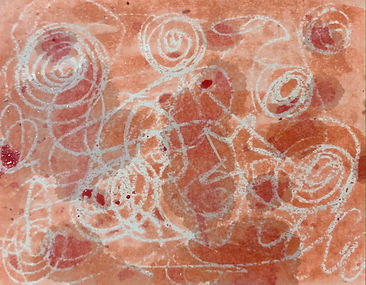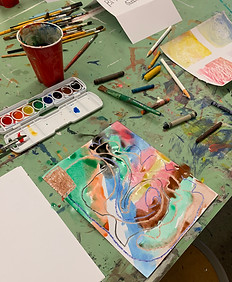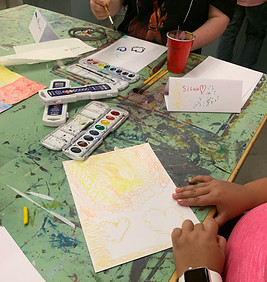top of page

Lesson #1:
Musical Watercolors
Date: 09/08/2021
Lesson Idea and Relevance: What are you going to teach and why is this lesson of importance to your students? How is it relevant to students of this age and background?
For Lesson 1 we are going to be teaching emotional and sensory processing through the use of music and watercolor. Music has the ability to evoke strong and powerful emotions. It is important for these students to understand how different sensory experiences can affect our moods and how we feel about our surroundings. These students possess a variety of different mental and physical abilities, and can sometimes feel a more powerful influx of emotions depending on the situation at hand. By utilizing art materials it is our hope that we can help these students process and express these emotions in a whole new way.
Essential Understanding (s): What are the “big ideas”? What specific understandings about them are desired?
The “big idea” for this project is to evoke a variety of different emotional responses through the use of music and allow students to express these emotions through their art. We hope that through this project students are able to better understand how different sensory experiences affect our moods, and how they can utilize art as an outlet for these emotions.
Essential Question (s): What provocative questions will foster inquiry, understanding, and transfer of learning?
Some leading questions we can ask:
What is your favorite type of Music? Ask Why?
What do you normally do when you feel frustrated, happy, sad, mad, etc.?
What colors do you associate with the emotion you are feeling?
How does this song make you feel?
Outcomes - Students will know...What key knowledge and skills will students acquire as a result of this unit? ...Art history and culture; expressive features and characteristics of art; art materials, tools, and techniques? What should they eventually be able to do as a result of such knowledge and skill? ...Compare and contrast artwork; analyze sketches? Students will be able to:
Students will be able to apply inner emotional interests to a productive and creative outcome. This overall creative outcome will be to show students that they can express their emotions through art, more spifficly through the use of crayons and watercolors during this lesson. Students will also acquire the skills that are required to work with crayons and watercolors while also seeing the effect that the crayon has when watercolor is painted on top of the crayon. Students will be exploring the different watercolor techniques, along with different drawing techniques to express the emotions they are feeling while listening to a song. They will not only be using their own imagination through invisible imagery but also uncovering a metaphorical demonstration. This lesson shows how emotion can be conveyed through artistic elements and poetic devices. Overall, students will be using various techniques to show their emotions on a sheet of paper while listening to music like scribbling, drawing, painting, and using salt to show a different result when working with watercolors.
Student Reflective Activity: Through what authentic performance task(s) will students demonstrate the desired understandings? How will students reflect upon and self-assess their learning?
-
Uncovering the drawing that they couldn’t see before in order to show how the activity made them feel without seeing it on the surface.
-
Applying emotion to physical imagery
-
Students will facilitate their own activities by working at their own pace and experimenting with various watercolor and drawing techniques.
-
Students will also demonstrate their understandings of the lesson by expressing their emotions on paper. They will show what colors they used and why they drew and painted the things they did to express those emotions.
-
They will be able to recognize and use these different techniques taught in further art projects and understand the effect that crayon has when you paint watercolors on top of it.
Assessment Instrument (s): By what criteria will “performances of understanding” be judged?
-
Engagement/trust in the process.
-
Evolvement through steps of the process.
-
Applying own personal interest (favorite color, shape, pattern, etc..)
Pre-assessment: How will you help the students know where the unit is going and what is expected? Help the teacher know where the students are coming from (prior knowledge, interests)?
This is the first time we will be meeting with this group of students so we as teachers don't have any prior knowledge to pre-assess for this group of students. So by creating a get-to-know-you lesson that starts off with making name tags was one of the main goals for this lesson so that everyone can feel comfortable getting to know one another so that we as teachers can get to know their certain abilities, strengths, and weaknesses for future lessons. To help students gain something from this lesson, we will imply how it can be incorporated into situational events that involve emotion. Events such as when a person is anxious and needs an outlet to describe his or her feelings. We can in terms direct a negative or emotional aspect to a positive aspect in order to show an audience what goes on in a person's mind through creative means.
Motivation: How will you hook all students and hold their interest?
Ask leading questions :
-Have you ever painted before?
>If you have, have you ever painted with watercolors? Did you like using watercolors to paint? I (personally) really love using watercolors to paint. I love how the colors blend softly together, and the interesting drippy effects I can get when I use them. It’s my (Bethany, any others that feel this way) favorite medium to make paintings with!
-Who loves listening to music!?
>What are your favorite types/genres of music to listen to? *let them answer* Mine is (each one of us lists our favorite kind of music or band)
-How many of you like to listen to music when you are doing something else?
>Have you ever drawn or painted while listening to music? Sometimes when you can’t think of anything to draw, playing music can help you get your creative juices flowing!
>Show teacher examples/ Give a demo
Ideation: How will you equip students, help them experience the key ideas, and explore the issues to generate ideas for their artwork?
-
Showing various kinds of music
-
Exposure to different watercolor techniques
-
Fun exploratory environment
-
Rhythmic/auditory learning
-
We will help engage students in this exploration by showing them an in-class demo and showing them a few teachers made examples that they can look at for reference
-
We will help students to experience the big ideas behind this lesson by showing them in class examples while showing them different techniques they can use to complete this lesson and express their emotions
Procedures: How is the lesson organized to maximize initial and sustained engagement as well as effective learning? Provide opportunities to rethink and revise their understandings and work? Allow students to evaluate their work and its implications? Include literacy and numeracy?
-1. Start off with introductions and ask motivating/prompting questions to students to help get them interested in and thinking about the project they are about to start. We will start off by making nametags as a get-to-know-you opener with crayons, markers, and watercolor paints.
- 2. After introductions teachers will introduce the project learning goals, guidelines, specific instructions for the project and give the students a visual demo of the lesson.
- 3. Materials will then be handed out to the students (already set up at the tables)
- 4. Teachers will then play the playlist of songs that the students can listen to and they will draw what they are feeling on the sheet of paper with a white crayon or colored crayon at their own pace. (majority of class time)
- 5. After the song has played and the students have decided they are done drawing they will then use watercolor to reveal the hidden marks that were left on the page during the duration of the song (majority of the class).
- 6. Students are able to use various watercolor techniques to reveal the hidden crayon marks like using paintbrushes and by using salt to make the watercolor paint do something different.
- 7. Students will repeat steps 4-6 throughout the class period while writing their names on the back for each painting after completion.
- 8. At the end when all paintings have been completed students will then pin their paintings together to make a “collaborative musical watercolor mural”. (Students that do not want to tape pieces together are welcome to keep theirs separated and/or take them home)
- 8. Students will then combine all their pieces together to make a combined wall mural (Students that want to take their pieces home are welcome too)
Materials, Resources, Safety: What is needed to complete the learning plan?
- Watercolor Paper
- Watercolor Palettes
- White Crayon/Colored Crayons
- A Variety of Music
- Paint Brushes
- Water cup
- Paper Towels
- Salt
- Markers
Accommodations/Differentiation: How is the lesson tailored (personalized) to the different needs, interests, and abilities of learners? ...Access (Resources and/or Process) and Expression (Products and/or Performance)?
This lesson is tailored so that each student has an individualized and open experience with straightforward guidelines. Each student was also free to work at their own pace while completing this lesson which made it less stressful for everyone in the class and the students were able to complete things and decide for themselves when they wanted to move on to another sheet of paper. Differentiation can be implied in an area of this lesson, in this way students are both learning the big idea of the lesson while completing the project in ways they would like to do so at their own pace.
Documentation
Teacher Examples:

The picture above shows what it would look like if students were to use a blue crayon and add many different watercolors on top of the crayon.

The picture above shows what it would look like if students were to use a pink crayon and pink watercolor on top.

The picture above shows what it would look like if students were to use a white crayon and if they were to add a few different colors on top of the white crayon.

The picture above shows what it would look like if students were to use a white crayon and then to add red watercolor on top.

The picture above shows a representation of what it would look like when the students combine their musical watercolors into a class mural.
Student Work:





All these photos that were taken during the lesson show the processes of the different students and how they apply watercolor on top of the crayon markings. They all used different colors and techniques to express their emotions while completing this lesson. The bottom
image is a "class mural" of all the pieces the students created during this project, which was awesome to see all of them put together in a community based mural, where every student contributed.
bottom of page